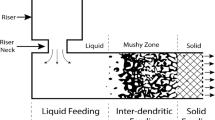Abstract
In the present work, effort has been made for modelling the microhardness of biomedical implant prepared by combining fused deposition modelling, vacuum moulding and stir casting (SC) process. A dynamic condylar screw (DCS) plate was selected as a real ‘3D’ biomedical implant for this case study. The DCS plate, made of acrylonitrile butadiene styrene material, was fabricated as a master pattern by fused deposition modelling. After preparation of the master pattern, the mould cavity was fabricated by the vacuum moulding process. Finally a metal–matrix composite of Al and Al2O3 prepared by SC process has been poured in the vacuum mould for fabrication of DCS plate. This study outlines the replication procedure of DCS plate in detail from the master pattern to final product. The contribution of the paper is towards finding out the effect and optimum values of three different process parameters (namely: percentage composition of Al and Al2O3, vacuum pressure and grain size of silica) towards microhardness of the DCS plate manufactured by the combined process.












Similar content being viewed by others
References
Singh R 2013 Process capability analysis of vacuum moulding for development of Al–Al2O3 MMC. J. Inst. Eng. (India): Ser. C 94(1): 93–97
Singh K and Singh R 2013 Experimental investigations for statistically controlled vacuum moulding solutions of Al–SiC MMC. Appl. Mech. Mater. 330: 91–95
Singh R and Singh G 2013 Replication of FDM based patterns via vacuum moulding. (Saarbrücken, Germany: Lambert Academic Publishing AG & Co. KG)
Singh R, Singh J and Singh J 2012 Macro-model for development of Al–Al2O3 metal matrix composite with vacuum moulding: designed experiments. J. Inst. Eng. (India): Ser. C 93(4): 325–330
Gu P and Li L 2002 Fabrication of biomedical prototypes with locally controlled properties using FDM. Ann. CIRP 51(1): 181–184
Gibson I, Cheung L K, Chow S P, Cheung W L, Beh S L, Savalani M M and Lee S H 2006 The use of rapid prototyping to assist medical applications. Rapid Prototyping J. 12: 53–58
Singh R and Singh J 2013 Macro-model for development of Al–SiC metal matrix composite with vacuum moulding: designed experiments. Mater. Sci. Forum 751: 21–26
Singh G 2013 Experimental investigations for replication of FDM based patterns by vacuum moulding in biomedical applications. MTech Thesis, Punjab Technical University, Jalandhar, India
Bakhtiyarov S I, Overfelt R, Black M G and Weiss D J 2005 Design and V-process production of cast magnesium component. Trans. Am. Foundrymen’s Soc. 113: 879–886
Kumar S, Kumar P and Shan H S 2007 Effect of process parameters on the solidification time of Al–7%Si alloy castings produced by VAEPC process. Mater. Manuf. Process. 22(7–8): 879–886
Singh R and Singh G 2015 Investigations of Al–SiC MMC prepared by vacuum moulding assisted stir casting. J. Manuf. Process. 19: 142–147
Singh R, Podder D and Singh S 2015 Effect of single, double and triple particle size SiC and Al2O3 reinforcement on wear properties of AMC prepared by stir casting in vacuum mould. Trans. Indian Inst. Met. 68(5): 791–797
Thrimurthulu K, Pandey P M and Reddy N V 2004 Optimum part deposition orientation in fused deposition modeling. Int. J. Mach. Tools Manuf. 44: 585–594
Acknowledgements
The authors are thankful to AICTE, New Delhi, for financial support.
Author information
Authors and Affiliations
Corresponding author
Rights and permissions
About this article
Cite this article
Singh, R., Singh, G. Investigations for modelling hardness of biomedical implant during replication of FDM-based patterns by vacuum moulding. Sādhanā 42, 327–333 (2017). https://doi.org/10.1007/s12046-017-0604-1
Received:
Revised:
Accepted:
Published:
Issue Date:
DOI: https://doi.org/10.1007/s12046-017-0604-1




